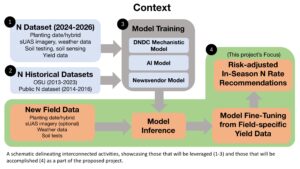Project Overview
Commodities
Practices
Proposal abstract:
Developing Practical On-Farm Research Tools for In-Season Field-Specific Nitrogen Recommendations
Context
This project is an integral part of a PhD research plan that seeks to ultimately provide tools for farmers to be more precise in N application rates. The overall PhD research project has 4 dimensions to it, of which funding is being requested in this application for item 4:
- Improved data pipelines for creating datasets at scale for use in optimizing Nitrogen Use Efficiency (NUE). This includes aggregating soil moisture sensing, weather data, and Small Unmanned Aerial Systems (sUAS) imagery from both university plot-level and on-farm research locations.
- Aggregation of historical datasets for NUE including:
- Ohio State replicated nitrogen trials from 2013-2023
- A public 47 site-year dataset from 2014-2016
- Application of the latest artificial intelligence approaches combined with the process-based DeNitrification-DeComposition (DNDC) model to provide improved generalized N recommendations.
- Development of practical on-farm research tools for fine-tuning of in-season field-specific N recommendations to be trialed with farmers for the 2025 and 2026 growing seasons.
The following graphic describes the overall PhD research plan with this project content in green:
Outputs
The outputs for this project (from item 4 above) include a digital tool with 3 features:
- Generation of prescriptions for replicated sidedress N trials.
- Visualization of yield response to nitrogen rates for a specific field to generate economic optimum nitrogen rates (EONR).
- Fine-tuning of an AI based nitrogen model based on field-specific data to generate field-specific in-season recommended nitrogen rates.
Outcomes
These outputs will enable participating farmers to realize that nitrogen can be managed more precisely (response-efficacy) and that the digital tool created enables them to be able to accomplish it (self-efficacy). This project will provide the basis for rolling the tools above out to a larger user base where the gains in profitability and reduced environmental impacts can be realized.
Approach / Methods
3 farmers in Western Ohio and a crop consulting and testing company in Central Ohio will participate in this research project. All 3 farmers and the crop consulting company are both technologically savvy and agronomically knowledgeable and can provide valuable feedback on the development of a digital tool that will be valuable for their farming operations. The tool will be developed to generate fine-tuning data from the 2025 growing season and to provide improved recommendations based on that fine-tuned data for the 2026 growing season.
Project objectives from proposal:
Our primary outcomes of this project are to demonstrate response-efficacy and self-efficacy for precision nitrogen application enabled by a well-designed digital tool:
Response-efficacy: Confidence that completing the action will have the desired effect.
Self-efficacy: An individual's confidence in their ability to successfully perform an action.
- Farmers will have a greater understanding of N dynamics on their field and recognize that precision nitrogen management is possible (response efficacy).
-
Farmers participating in the project will be confident that they can more precisely manage N application using the digital tool (self-efficacy).
-
Understanding of farmer interest in scaling the tool beyond those participating in this project.
- Drive further research in academia of aggregating current and historical N datasets for AI model training as well as the importance of using on-farm research and digital tools for fine-tuning AI models in agriculture and drive adoption of precision N management practices.
The outcomes listed in this project are enabled by the digital tool that is intended to provide more accurate nitrogen recommendations for a specific season and field by fine-tuning a generalized nitrogen model, and are intended to engage farmers in a way that they trust the recommendations while also making it simple to execute the recommendations by creating digital prescriptions. From our discussions with farmers, we have found many to be using flat rates of nitrogen for their fields and have either been unaware of nitrogen frameworks such as MRTN or Adapt-N, or have been skeptical that they are appropriate for their fields.
